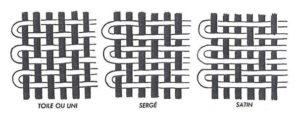Weaving, invented in ancient times, has not fundamentally changed for thousands of years: yarns, of natural or synthetic origin, are intertwined to produce fabric.
Standard weaving technique
Weaving is the process of interlacing warp threads (vertical) and weft threads (horizontal) in a specific sequence. The manner in which the threads are interlaced is called the weave. There are three primary weaves: plain, the oldest and simplest weave, as well as twill and satin. All other weaves are derived from one or a combination of these types.
It is also possible to produce woven patterns, using either weft or warp effects, or different base weaves. The fabric is then said to be “worked”. The Museum Chapel features some beautiful examples.
Weaving looms
The first primitive weaving looms, used several thousands of years ago, had a very simple vertical and horizontal structure. Counterweights controlled the tension of the warp threads, thereby facilitating the interlacing of the weft threads. Over the years, the textile industry has continued to evolve, with the creation of new looms that simplify weaving using a system which lifts some of the wrap threads, creating an empty space (called a shed) which allows the weft threads to be pulled or thrown across in a single pass.
There are two types of looms:
- Hand looms, manually operated by one or more people, such as the Chinese draw loom displayed in the Chapel;
- Fully automated mechanical looms, such as the Diederichs 7 700 or CRK4B looms. These looms perform the following four operations automatically and synchronously: raising and lowering the frames that control the warp threads, launching the shuttle that feeds the weft thread into the shed, compacting the woven threads with a reed, and progressively feeding the warp to enable continuous weaving. Conceived at the end of the 18th century, mechanical looms only took off with the availability of electricity at the beginning of the 20th century.
But in spite of technological advances, the basic function has remained the same for centuries: the loom secures the warp threads at the desired tension, allowing the weft threads to be woven between them.


